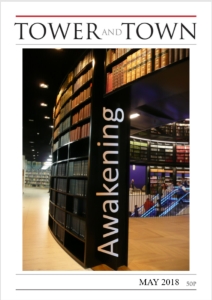

Tower and Town, May 2018 (view the full edition) (view the full edition)The Little Prince Of The TerracesThe 1943 universal classic of Le Petit Prince deals with love, friendship, and the desert. In the story a pilot crash-lands in the desert and meets a small boy from a distant asteroid. When Antoine de Saint-Exupéry, known simply as "Saint Ex", wrote and illustrated the story he benefited from his own 1926 to 1929 flying experience and desert crash-landing whilst flying single-engine planes from Toulouse in France to North Africa. The present take on Le Petit Prince employs "stars & flights" metaphors and real-life events of child awakening plus father/son friendship within a Christian/Muslim setting in Mosul, Iraq. Its backdrop is the gathering political storm over Suez, and the forthcoming publication of "Synthesis of the Elements in Stars" in the 1957 Review of Modern Physics. Awakening of the Heart When he was six the little prince had already been awakened to the magic of seeing things with the heart and to the enriching solitudes on roof terraces. "And now here is my secret, a very simple secret: It is only with the heart that one can see rightly; what is essential is invisible to the eye." Antoine de Saint-Exupéry His "seeing with the heart" was honed on metaphorical flights with his beloved rational father, who we should now appropriately call the aviator. And because both the prince and the aviator saw with the heart they understood quite well that great love defies all spoken words and that humility is a virtue. "And when you finally discover yourself, my son, you will be basking in the knowledge that one is neither less nor more than the others, and that to love is to not own". The prince's fabled life flourished in the city of Mosul, whose skyline consisted of a sea of roof terraces with occasionally protruding minarets. It was here across the river Tigris from ancient Nineveh that the prince's seeing with the heart was refined, and his love of the aviator cemented. It was also here on his home's roof terrace that he played, brushed with nature by watching fighting sparrows, and listened to the sounds emanating from the alleyway below, the neighbouring houses, and the nearby leaning minaret. It was also on this roof terrace within the Christian/Muslim neighbourhood of Al-Sa'a, (Arabic for The Clock), that the time dials sometime stopped when he joined the aviator on thought flights over pre-1920's Al-Jazeera plain, Arabic for Bit Nahren (Aramaic for the land between the Tigris and Euphrates in upper Mesopotamia, pre-Iraq),. It was in Al-Jazeera that the aviator spent his formative years among the Muslim Arab tribes and acquired nomadic skills for reading the night sky. Reaching for the Stars As spring gave way to summer, beds were carried up to the roof terrace. This was, of course, time for great excitement as lonely nights within the indoor featureless darkness are replaced by the sheltering under the monumental night sky. It was here that when the daylight failed, and the mu'adhin called from the minaret, the prince often sat beside the aviator on one of the beds, beneath the enormous leaning minaret, to go over the desert tales till the star studded indigo sky tuned to darker shades of blue and the prince climbed into his small bed. Here a recurring thought often crossed his mind as he gazed at the powerful scenes played above. He should ascend the overhead darkened looming minaret and hop to the nearby stars in order to experience different worlds, look down at his empty bed and wave to his parents, brother, and sister. This should prove to be pleasing for the navigator, "You can fulfil your aspirations by aiming for the stars and not looking back". However, it often seemed that once he fell asleep time galloped so quickly until he was awakened by the mu'adhin dawn call for Muslim prayers emanating high above his head. ♦♦♦ The Mosul Great Mosque of Nur Al-Din, (Arabic for the Light of Religion), was built under Nur Al-Din Al-Zangi, Atabeg of Aleppo, The elaborate 15.5 m leaning minaret is called Al-Hadba (The Humped). Mosul is commonly identified with the iconic minaret, the city itself often being named Al-Hadba, an association abruptly ended in July 2017 when the minaret was blown up during the final offensive to dislodge Islamic State from Mosul. ♦♦♦ Raik Jarji |